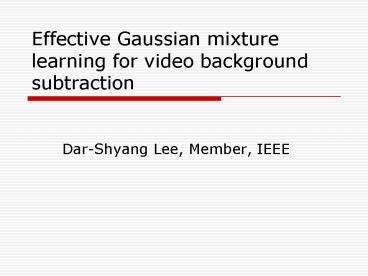Effective Gaussian mixture learning for video background subtraction - PowerPoint PPT Presentation
1 / 19
Title:
Effective Gaussian mixture learning for video background subtraction
Description:
The basic algorithm follows the formulation by Stauffer and Grimson [9] Differences: [9] C. Stauffer and W.E.L. Grimson, 'Adaptive Background Mixture Models for Real ... – PowerPoint PPT presentation
Number of Views:803
Avg rating:3.0/5.0
Title: Effective Gaussian mixture learning for video background subtraction
1
Effective Gaussian mixture learning for video
background subtraction
- Dar-Shyang Lee, Member, IEEE
2
Outline
- Introduction
- Mixture of Gaussian models
- Adaptive mixture learning
- Background subtraction
- Experimental results
- Conclusions
3
Introduction
- Adaptive Gaussian mixtures
- Used for modeling nonstationary temporal
distributions of pixels in video surveillance
applications for a long time - Been employed in real-time surveillance systems
for background subtraction and object tracking - Balancing problem
- Convergence speed and stability
- The rate of adaptation is controlled by a global
parameter that ranges between 0 and 1. - too small Slow convergence
- too large Modeling too sensitive
4
Introduction
- This paper proposes an effective online learning
algorithm to improve the convergence rate without
compromising model stability - Replacing the global, static retention factor
with an adaptive learning rate calculated for
each Gaussian at every frame - Significant improvements are shown on both
synthetic and real video data.
5
Mixture of Gaussian models
- Goal
- Flexible enough to handle variations in lighting,
moving scene clutter, multiple moving objects and
other arbitrary changes to the observed scene - Modeling each pixel as a mixture of Gaussians and
the adaptive mixture model are then evaluated to
determine which are most likely to result from a
background process. - Our background method contains two significant
parameters a, the learning constant and T, the
proportion of the data that should be accounted
for by the background.
6
Mixture of Gaussian models
- New frame arrives
- Update parameters of the Gaussians
- The Gaussians are evaluated using a simple
heuristic to hypothesize which are most likely to
be part of the background process.
7
Mixture of Gaussian models
- The probability of observing the current pixel
value is - Gaussian probability density function
- Every new pixel value, Xt, is checked against the
existing K Gaussian distributions - A match is defined as a pixel value within 2.5
standard deviations of a distribution1.
8
Proposed Algorithm
- The parameters of the distribution which matches
the new observation are updated as follows - Background Model Estimation
- Consider the accumulation of supporting evidence
and the relatively low variance for the
background distributions - New object occludes the background object
- ? Increase in the variance of an existing
distribution. - First, the Gaussians are ordered by the value of
?/s.
9
Background Model Estimation
- First, the Gaussians are ordered by the value of
?/s. - Then, the first B distributions are chosen as the
background model - T is a measure of the minimum portion of the data
that should be accounted for by the background - Small T unimodal
- Large T multi-modal
10
Adaptive mixture learning
- Learning rate schedule
- Local estimate
- Learning rate
- A solution that combines fast convergence and
temporal adaptability is to use a modified
schedule - is computed for each Gaussian
independently from the cumulative expected
likelihood estimate.
11
ProposedAlgorithm
12
Proposed Algorithm
- The basic algorithm follows the formulation by
Stauffer and Grimson 9 - Differences
- ?
- ?
- ?
9 C. Stauffer and W.E.L. Grimson, Adaptive
Background Mixture Models for Real-Time
Tracking, Proc. Conf. Computer Vision and
Pattern Recognition, vol. 2, pp. 246-252, June
1999.
13
Proposed Algorithm
- This modification significantly improved the
convergence speed and model accuracy with almost
no adverse effects. - Winner-take-all option where only a single
best-matching component is selected for parameter
update is typically used. - ? Starvation problem
- Soft-partition All Gaussians that match a data
point are updated by an amount proportional to
their estimated posterior probability - Improve robustness in early learning stage for
components whose variances are too large and
weights too small to be the best match.
14
Background subtraction
- Temporal distribution P(x) of pixel x
- Density estimate
- We train a sigmoid function on w/a to approximate
P(BGk) using logistic regression - The foreground region is composed of pixels where
P(Bx) lt 0.5.
15
Experimental results
- The proposed mixture learning is tested and
compared to conventional methods9 using both
simulation and real video data. - Mixture Learning Experiment
- Evaluated through quantitative analysis on a set
of synthetic data. - Converged faster and achieved better accuracy.
- Background Segmentation Experiment
- Successful segmentation in early stage
- Quick convergence
9 C. Stauffer and W.E.L. Grimson, Adaptive
Background Mixture Models for Real-Time
Tracking, Proc. Conf. Computer Vision and
Pattern Recognition, vol. 2, pp. 246-252, June
1999.
16
Mixture Learning Experiment
17
Experimental results
18
Experimental results
19
Conclusions
- We presented an effective learning algorithm that
improved convergence rate and estimation accuracy
over the standard method used today - The results were verified by a large number of
simulations over a range of - parameter settings and distributions.































